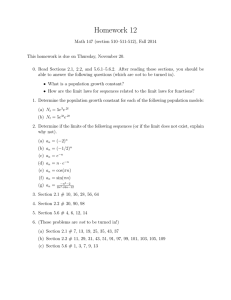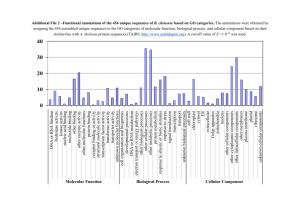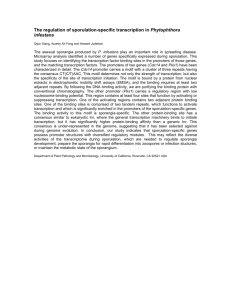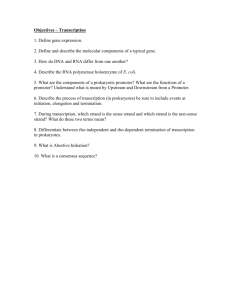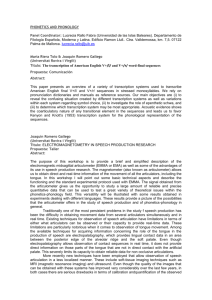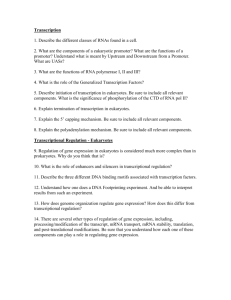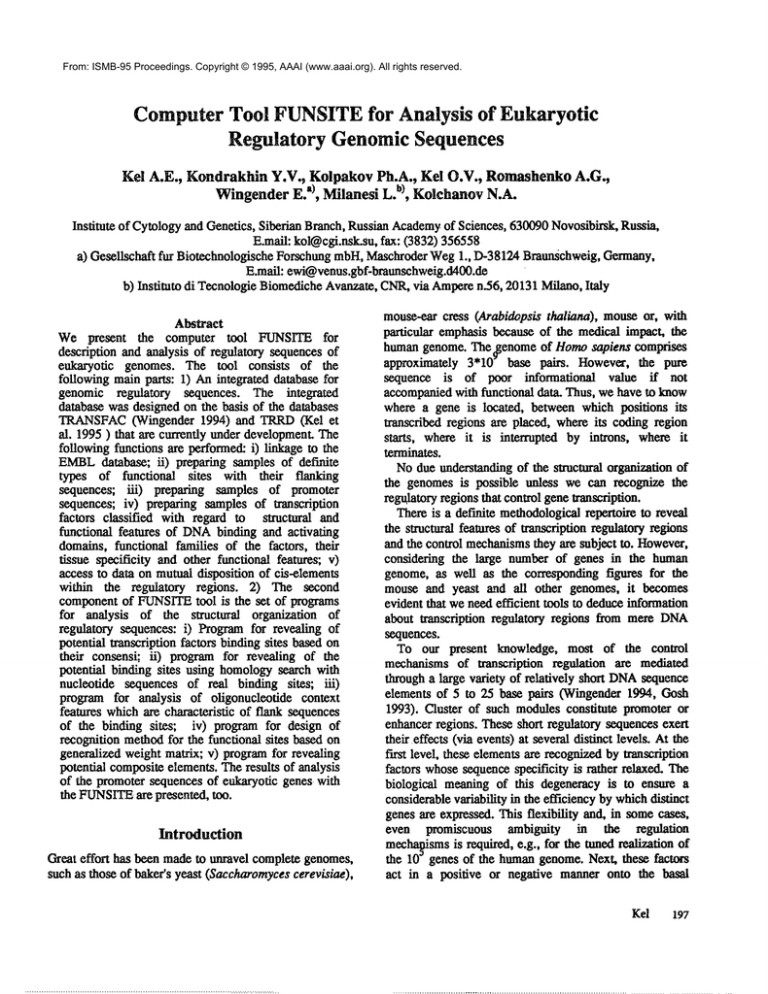
From: ISMB-95 Proceedings. Copyright © 1995, AAAI (www.aaai.org). All rights reserved.
Computer Tool FUNSITE
for Analysis of Eukaryotic
Regulatory Genomic Sequences
Kel A.E., Kondrakhin Y.V., Kolpakov Ph.A., Kel O.V., Romashenko A.G.,
Wingender E. a), Milanesi L.b), Kolchanov N.A.
Institute of Cytologyand Genetics, Siberian Branch,RussianAcademy
of Sciences, 630090Novosibirsk,Russia,
E.mail: kol@cgi.nsk.su,fax: (3832) 356558
a) Gesellschaft fur BioteclmologischeForsehungmbH,MaschroderWeg1., D-38124Brannschweig,Germany,
E.mail: ewi@venus.gbf-braunsehweig.d400.de
b) Instituto di TecnologieBiomedicheAvanzate,CNR,via Amperen.56, 20131Milano, Italy
Abstract
We present the computer tool FUNSITEfor
description and analysis of regulatory sequencesof
eukaryotic genomes. The tool consists of the
following mainparts: 1) Anintegrated database for
genomic regulatory sequences. The integrated
database was designedon the basis of the databases
TRANSFAC
(Wingender 1994) and TRRD(Kel
al. 1995) that are currently under development.The
followingfunctions are performed:i) linkage to the
EMBL
database; ii) preparing samples of definite
types of functional sites with their flaking
sequences; iii) preparing samples of promoter
sequences; iv) preparing samples of transcription
factors classified with regard to structural and
functional features of DNAbinding and activating
domains,functional families of the factors, their
tissue specificity and other functional features; v)
access to data on mutualdisposition of cis-elements
within the regulatory regions. 2) The second
componentof b73NSITE
tool is the set of programs
for analysis of the structural organization of
regulatory sequences: i) Programfor revealing of
potential u’anseriptionfactors bindingsites basedon
their consensi; ii) programfor revealing of the
potential bin ,ding sites using homology
search with
nucleotide sequences of real binding sites; iii)
program for analysis of oligonucleotide context
features whichare characteristic of flank sequences
of the binding sites; iv) program for design of
recognition methodfor the functional sites based on
generalized weightmatrix; v) programfor revealing
potential compositeelements.Theresults of analysis
of the promotersequences of enkaryotic genes with
the FUNSITE
are presented, too.
Introduction
Great effort has been madeto unravel completegenomes,
such as those of baker’s yeast (Saccharomyces
cerevisiae),
mouse-earcress (Arabidapsis thaliana), mouseor, with
particular emphasisbecauseof the medicalimpact, the
humangenome. The agenomeof Homosapiens comprises
approximately 3"10- ha se pairs. Howevex,the pure
sequence is of poor informational value if not
accompanied
with functional data. Thus, wehave to know
where a gene is located, between whichpositions its
transcribed regions are placed, whereits codingregion
starts, where it is interrupted by introns, where it
terminates.
Nodue understandingof the structm’al organiT-qtionof
the genomesis possible unless we can recognize the
regulatoryregionsthat control genetranscription.
Thereis a definite methodologicalrepertoire to reveal
the structural features of transcriptionreg~_,|~toryregions
and the control mechanisms
they are subject to. However,
considering the large number of genes in the human
genome,as well as the corresponding figures for the
mouseand yeast and all other genomes, it becomes
evident that weneedefficient tools to deduceinformation
about transcription regulatory regions from mere DNA
sequences.
To our present knowledge, most of the control
mechanismsof transeription regulation are mediated
througha large variety of relatively short DNA
sequence
elements of 5 to 25 base pairs 0Vingender1994, Gosh
1993). Ouster of such modulesconstitute promoter or
enhancerregions. Theseshort regulatory sequencesexert
their effects (via events)at several distinct levels. At the
first level, these elementsare recognizedby transcription
factors whosesequencespecificity is rather relaxed. The
biological meaningof this degeneracy is to ensure a
considerablevariability in the efficiencyby whichdistinct
genes are expressed. This flexibility and, in somecases,
even promiscuous ambiguity in the regulation
mec.l~smsis required, e.g., for the tuned realiT~tion of
the 10 genes of the humangenome.Next, these factors
act in a positive or negative manneronto the b~_~l
Kel 197
transcription initiation complexand, finally, on the
regions.
activity of the RNApolymemsethrough a hierarchy of
Effective computer methods for analysis of this
protein-protein interactions. Acomplexstructm~of the
information are required, too. Wehave developed the
regions of genetranscription regulation arranges for this
computer tool FUNSITEwhich comprises two main
hierarchy.It is the structure of the regulatoryregionsthat
componentparts: 1) an integrated database for genomic
holds encodedall potentially possible waysof regulation
regulatory sequences; 2) programsfor analysis of the
of the geneundervarious conditionsof expression(tissue
structural orza_niTation
of regulatorysequences.
specificity, stage of organismdevelopment,stage of cell
cycleetc.)
The integrated database on genomic
The most important feature of organization of the
transcription regulatoryregions is their modularstructure
regulatory sequences,
(Dynan, 1989) and recoLmiz~dlevels of hierarchy. The
Thereis available
nowadays
a range of databases
on
lowestlevel in the hierarchycorrespondsto cis-regulatory
genomic
regulatory
sequences:
TRANSFAC
( Wingender
element,
which
binds
a definite transcription
factor.
1994),
TRRDflg,elet al.1995),
TFD(Gosh
1993)
Really,
mosttranscription
factors
bindto DNAas
EPD
(Bucher
1993).
The
integrated
database
we
report
dimmers
which
provides
considerable
variability
ofthe
based
upon
the
first
two.
interaction betweentranscription factors and their binding
The database TRANSFAC
collects
dataon regulatory
sites. For example,the bZIPclass of trans-acting factors
genomic
sites
and
on
transcription
factors
andthus
interact with the DNAthrough a positively charged
consists
of
the
two
main
records
SITES
and
FACTORS,
to
(basic) region and, as a prerequisite, have to dimerize
which
several
_additional
records
are
connected.
The
through hydrophobicinterfaces called leucine zippers.
additional features they contain are deducedfrom the
Onelarge subgroupof the bZIPfactor family, the CREB
basic mechanisms
of gene regulation.
AP1- factors, comprisesat least 19 polypeptidesthat are
As a data managementsystem for the TRANSFAC
d~t_a
able to form more than 37 dimmers of different
set,
we
have
developed
TRANSFAC
retrieval
program
composition. The second level correspondsto composite
(TRP). It is a network-modelsystem that provides very
response elements (Diamondet al. 1994). In most cases,
rapid data access throughphysical link.~ ("sets") between
the compositeelementis formedof adjacent or partially
related
entries.
Many-to-many
relations betweenrecords
overlappingsites for proteins whichbelongto different
are
established
through
common
member
records
thatmay
factor families and to different signal transduction
holdadditionaldata qn_alifyingthe relation (Knuepel
et al.
pathways. At the level of compositeelements, a lot of
1994
).
waysfor gene expression regulation are offered. CrossTranscription regulatory region database (TRRD)was
coupling of two different factors at a compositeelement
developed to provide the comprehensive research
exhibits a newpattern of transcription regulation, for
onmechanisms
controlling eukaryotic gene expression at
example,tissue-specificity of hormonalinduction, ~suethe
transcriptional
level. In this databasewecollect dam
specificity of immuneor acute-phase response, etc. In
concerning
various
features of regulation of gene
somecases, one of the binding sites forminga composite
expression,
gene
classifications,
structure of the gene
elementis a lowaffinity bindingsite This is accountedfor
regulatory
regions,
composite
elements
etc.
by stabilization of bindingof the transcription factors to
Howthe integration of TRANSFAC
and TRRDwas
DNAbccanse
ofadditional
protein-protein
interactions,
which
opens
morecomplex
waysof generegulation.
Several compositeelements and/or individual binding
sites are combinedin promoters and enhartcers. At the
level of these structm’es,the specificity andmultipleways
~SFAC
of regulationare providedby the entire set of the sites and
compositeelements.Finally, the highest level of hierarchy
is integrity of all the regulatoryregionsof the gene.
Thus, a huge variability of DNA-protein
and proteinprotein interactions providesa highly complexpattern for
the regulationof geneexpressionin eok_a_ryoticorganisms.
The understanding of the transcription regulation
mechanisms, so complex, and factors controlling
transcription, so numerous,can be achievedvia databases
Figure1. TRANSFAC
and TRRD integration
scheme.
on transcription factors and transcription regulation
198
ISMB-95
15-lettered code. The programdeveloped detects all
achieved is schematically presented in Fig.1. An
regions similar tO the consensus in the nucleotide
additional table, GENES,
contains the list of all the genes
described in both databases. The GENES
allowed one-tosequence under study. The program reveals potential
binding sites that contain few nucleotides not matching
one correspondence(Fig.l., double arrows) to be set
the consensus. The percentage of mismatches was
between the tables of TRANSFAC
and TRRD.
designated as t. This parameter allows the functional
The integrated database TRANSFAC/TRRD
is linked
tO the EMBLdata library and tO the SWISSPROT variability of bindingsites tO be considered.Byusingt we
database as well as tO EPD. The enkaryotic promoter
can reveal poor binding sites not matchingperfectly its
database (EPD)contains precise data on manye-karyotic
consensus,yet functionally active. Onthe other hand, the
promoters
thathavebeenexperimentally
revealed;
it
higher t, the higher the number of binding sites
indicates
transcription
initiation
sites
andclassification
of
erroneouslyidentified as being active, that is whythe
allpromoters
described
by functional
andstructural correct choiceof t is of great importancehere.
similarity
andinaccordance
withsomecommon
feature,
s
of generegulation.
Linkage
between
EPD,EMBLand
TRANSFAC/TRRD
is denoted
inFig.1 by single
arrows.
Thefollowing
basic
functions
oftheintegrated
database
can be specified: i)linkage to the EMBL
database; ii)
preparing samples of definite types of functional sites
with their flanking sequences; iii) preparing samplesof
promoter sequences;, iv) preparing samples of
transcription
factors
classified
asregards
structural
and
functional
features
of DNAbinding
andactivating
domains,functional families of the factors, their tissue
specificity andthe functionalfeatures; v) accesstOdata on
e
mutual
disposition ofcis-elements within the regulatory
-500
¢1
regions.
fl 2= 8.2
Oct.1 atge~aay
Computer programs for analysis of the
genomic functional regions.
Figure 2. An example of the uncvcmdistribution of binding
sites for Octamcr family membersin the promoter sample
By using this method, we have ~nalyzed a sample of
Wehave developed computer programs that have been
RNA
polymerase H promoters. A sample of P---470
included
intothe FUNSITE
system. The system contains
promoters
each of 600 bp in length fromvertebrate genes
thefollowing
mainprograms
for analysis
of the
was
selected
from the EPDdatabase. Weselected
characteristics
ofregulatory
genomic
regions:
i)
sequences
with
lengths over 500 bp upstream of the
programfor revealing the potential binding sites for
transcription
start
andoverI00bp downstream
of the
transcriptionfactors on the basis of their consensuses;
ii)
transcription
start.
Then
we
broke
the
promoters
intO
programfor revealing the potential binding sites by
subregions
and
analyzed
the
concentration
of
transcription
searching for homology
with nucleotide sequencesof real
signals in each. Theparameterm stands for the numberof
binding sites; iii) a program for analysis of
the promotersubregions. In our study m wasranging from
oligonueleotidecontext features whichare characteristic
50 tO 80. Analysis has revealed that a range of binding
of the sequencesflanking the binding sites; iv) a program
sites within the promotersarc distributed unevenly.The
for constructionof a recognitionmethodfor the functional
unevenness was estimated by Smimov’sstatistic ~2
sites based on a gener~liTedweightmatrix; v) a program
for revealing potential compositeelements.
(Darling 1957). Anexampleof the unevendistribution
one well-known
binding site Oct-1 in the promotersample
is presented in Figure 2. The large numberof unevenly
Revealing potential transcription factor binding
distributed potential transcription factor bindingsites is
sites by consensus
characteristic of the eukaryotic promoter
structure.
Toreveal potential transcription factor bindingsites, we
Noteworthy, the binding sites for wide spread
haveused a compilationof transcription signals (Faisst
transcription factors. AP2,TBP,Spl, NF-IL6,E2A,EGRMeyer 1992). The compilation consists of k = 136
1, HSF,NF-1, Oct-1 are fo,und amongthe most unevenly
consensi of binding sites. The consensus lengths range
distributedsi’~s.
from5 bp to 24 bp, the consensiare described by using a
Kd 199
Recognition of potential transcription factor
bindingsites by patterns of real sites.
As a first step in the developmentof the method,weset
up a compilation of aligned sets of patterns of real
wanscriptionfactor binding sites. Somesets of the real
sites fromthe compilationare presented in Figure 3. The
recognition procedurewas as follows. If a region of DNA
in question exactly matchesone of the sequencesof the
set of patterns, the region will be identified by the
programas being a potential bindingsite. Thecompilation
wasbuilt up as follows.
1) The sites that were experimentally shownto bind
transcription factors of one subfamilywereselected fxom
the databases TFD, TRANSFAC
and TRRD.By saying "a
subfamily" we mean a group of closely related
transcription factors with very similar binding sites in
vertebrate species. Weconsidered only those subfamilies
for whichmorethan 6 bindingsites havebeenreported.
2) Find the core motif common
to all sites of a given
subfamily(see Fig.3: for the GATA
subfamily, this motif
is GAT
trinucleotides)
3) Alignall the sequencesof the subfamilyrelative to
the motif (withoutgaps).
4) Toforma set of patterns fromthe sampleof sites, we
heed the following steps: (i) Extension of the current
windoww at either direction by one nucleotide from the
core motif. (ii) Determinethe most frequent sequenceSw
within the current window
w for the given sampleof sites.
Off) The sequence fragments within the windowwill be
considered as the current set of patterns. Sequencesare
included only for sites that have not more than 1
mismatchwith the most frequent sequenceSw within the
current windoww. Theother sequencesof sites (if any)
are omittedfromthe set of patterns. (iv) Checkthe type
errors of the recognitionprocedures.Thetype I error was
evaluatedon the basis of the numberof sites omitted from
the sets of patterns.
5) Iterations terminateand the ultimate set of patterns
is thoughtto be built if the typeI error is not over 10%.
Comparativeanalysis of overprediction errors (type
errors) in the recognition of potential binding sites was
performedfor each of the subfamilies of transcriptional
factors. To evaluate the type H errors we used a
representative sampleof eukaryotic exon sequencesof a
total length of 348000bp. The sampleconsisted of only
internal exons of genes whereno real transcriptional
factor binding sites are practically observed. Table 1
presents the first ct1 andseconda2 type errors for all the
sites in question and, to comparewith, the prediction
errors for the sites by using the consensusmethod.Ours
seems to be more successful. The point is that our
approach takes account of the correlation between the
20o ISMB-95
positions within the sites. Really, as is seen for the
compiledGATA-1
binding sites, the last two positions are
described by RS(Fig. 3), but becauseof the correlation
betweennucleotidesat the two positions, this description
is not so detailed as the set of the real sites. In reality,
only AGor GCoccursat these sites at the givenpositions,
and none of ACor GGthat fits in with the RSconsensus.
Thus, the overprediction error following the real site
methodis lower. However,the consensus methodallows
one to recognizepotential bindingsites for such factors
that are not yet properly studied and for whichjust few
real sites as these are known.The similar approachfor
revealingof transcription factor bindingsites wasused by
Prestridge and Burks (1993) wherethey were comparing
the density of transcriptional elementsin promoterand
non-promoterregions.
Recognition of Pol II promotersby using binding
sites for transcription factors.
Compilation of transcription signals (Faisst & Meyer
1992) whichconsists of 136 consensi of transcription
factor binding sites is used for recognition of Pol II
promoters. As was described above, we divide the
promoter region into subregions and analyze the
concentrationof transcription signals in each of them.The
parameter m that we used in our modelis the numberof
analyzedsubregionin the promoters.Onthe bases of the
analyzedset of promoterswebuild the matrix:
T=]Tifl,t=[tij[; i=l,k; j=l,m.
whereTij is the number
of incidencesof the ~-th signal (i
= 1,136) in the j-th subregion through th,, all set of
promoters.
Basedon the matrix T, we have constructed a method
for recognitionof promoterregions. For each subsequence
Zf(zl,z 2 ..... zl.,), whereL=600bp, wecalculate a measure
of it beingsimilar to the promotersample:
=
x .,:,j.where
i=i
the
j=l
elementsof matrixT; nij is the numberof occurrences
of
the i-th signal in the j-th region of the sequenceZ; wi is
the weightcoefficient for the i-th signal. Theweightwi is
ascribedto the i-th transcriptionsignal X=(xl,x2,...,xh) of
length h, wherexr is a symbolof a 15-letter code. The
weightwi is calculatedas follows:
wi = w(X)
where~Xr)is the
probability
of the letter xr occurring
in a random
sequence. Weassume
AP-2
ccccaggo (5)
cTccaggc(2)
cccGaggc(2)
ccccTggc(2)
ccccagCc(2)
ccGcaq~c(I)
ATF/CREB
tgacgt (28}
tgacgA (5)
tgacgG (2)
tgacgC (2)
tgGcgt (I)
E2F
cgcgaaaa(8)
cgGgaaaa(4)
cgcgaaaC(I)
GATA
agataag (4)
agatagQ(2)
tgataag (2)
tgatagc (i)
tgatTag (i)
t(;ataaA(i)
Fig.3.Examples
.for sets of patternsfromthe eompilatiom
In parentheses:so-many
sites fromTFD
of the give~asubfamily
matchthe
givenpattern.
I
Factor subfamily Consensus
name
Consensus method
al*
(%)
(%)
Exon
set
AP-2
ATF/CREB
E2F
GATA
Spl
CCClVg~SSS
TGACGYMA
TITrSSCGS
WGATAR
KR~
54.0
51.0
17.0
39.0
52.0
0.469
0.002
0.005
0.113
0.071
Site pattern method
al
a2
(%) (%)
Promoter
Exotl
set
sot
0.819
0.068
0.001
~40 0.120
0.007
5.0
0.004
] 15.4
0
0.137
0.037
0.167
[ 12.5 0.101
Promoter
set
0.075
0.II0
0.006
0.047
0.203
Table1. Examples
of calculationof the typeI andHerrors at recognitionbythe consensus
method
andsite patternmethod.
*- typelerror;**- typelrm-ror
p(i)=p(T)ffip(G)fp(C)=l
recognition
methodreinforced by this division
extn’bits
a
p(R)=p(Y)=p(W)=p(S)=p(M)=p(K)=
lower
typeI error andthe ~metype H error.
p(B)=p(V)=p(H)=
p(D) =314; p(N)=1.
type I error typeII error
Method
So, the signals that havea lowerprobability of occurrence
(at)
(a2)
in a randomsequenceget the higher weightw.
Recognition
by
TATA
box
48%
10.8%
Let Z be a sequence under consideration.
Let
Recognitionon the basis
R1,R2,...,RP be a set of randomsequences.Theparameter
of potential bindingsites
34%
9.3%
IX is evaluated for every randomsequencer1=Ix (R1,T),
without
cluster’re,
ation
.... rp=IX(Rp,T). The estimate b*--max{IX(Ri,T)}
Recognitionon the basis
11%
9.5%
used as a thresholdvalueof IX for identification of Z. If
of potenl~tl bindingsites
IX (Z,T) > b*, then sequenceZ is identified as a promoter.
after elusterization
For a more precise thresho!d value, we use random
Table2. Testingof the methods
for re.cognitionof vertebrate
sequences simulated for the basis of the dinucleotide
promoters.
frequencies typical of the promoters of the sample.
Randomsequences generated in this way and the
Analysis of the context features of sequences
promoters are similar in contextual featm’es, but the
flanking transcription functional sites.
formerare certainly ~mableto function as true promoters.
Predicting ability surely rises, since we can now
The system FUNSITEoffers the following means to
distinguish promoters from other sequences with very
analyze
the contextfeatures of functional sites with:
I)a
similar contextualcharacteristics.
program
foranalysis
ofthe unevenness
ofthe distribution
Table 2 presents resdlts of a cheekof the method.The
ofshort
oligonucleotides
along
thesite;
2)a program
for
type I error wasestimatedon the set of 470 promotersby
determination
of dinucleotide weight consensi; 3) the
using of the jack-knife method. The type II error was
program
for revealing oligonucleotidesin 15-letter code
esfinmted on the sample of oxen sequences which was
typicalof definite regionsof sites.
described upper. As is seen, it provides higher accuracy
As an example,we consider a sample of CREelements
_than the methodbased on revealing of TATA
box (Bucher
from vertebrate
genomes.
The samplewas created using
1990).
Besides, wegrouped
the promoters
withsimilar the TRANSFAC
database and EMBL
data library. All the
pattca’ns
of distribution of thesignals along
thesequences sequenceswere uniform
inlength (98 bp), and contained
(Kondrakhin1995). Eight groups were determined. The
the core sequence TGACgtat position 46. The saml~le
Kel 201
consisted of 31 sequences. All the sequences in the
sample are aligned to optimal matching to the TGAC
core
sequence.
position importance so that the resulting dinucleotide
weight consensus differs most from the distribution of
dinucleotide frequencies in an alternative sample.
Analysis of short oli~onucleotide distribution
Smimov’sstatistic [’~ mentionedabove was applied to the
analysis of the distribution of short oligonucleotides along
the sequences containing CREelements.
.... c c ....... ccE....................
AC
/r
cG
GG
TG
CT
GT
1T
AT
CA
GA
TA
-6
Ac
cG
~
~
GG
TG
~
CT ----~
~
CA
GT
"IT
AT
~
_~
It.
0
~[:-
GA
TA
~
5
10
-6
a)
Fig. 4. The observeddistribution of trinucleotid~ in CRE
clement flanking sequences. Present 43 positions around the
core of CRE element. Each colon ~ to one position.
Heightof the colerrmgives frequencyof the given trinucl¢odd~
starting fxomthe correspondentposition.
.~
0
5
b)
TINACG
~.,M
c)
Fig. 5. Dinueleotid¢weighteonsensi, a) eREelementleft
A strongly
nonrandom distribution
of di- and
hand flank; b) CREelement right -hand flank, c)fL fRtrinucleotides along the sequences of CREelements was
function of position "importance"for the left-hand madrightrevealed. As is seen from the Figure 4, the most typical
handflank.
features of the sequences flanking CREelements are
Weuse the exon sequences as the alternative sample in
represented by the distribution of the short stretches CCC
the analysis. Fig.5 presents bar diagrams for two
and TIT. The stretch CCCoccurs in left-hand flanking
dinucleotide consensuses, typical of the left-hand and
sequences of the CRE element with abnormally high
right-hand flanking sequences, respectively.
The
frequencies. The stretch TIT is rather confined to rightcorresponding functions of "importance" of positions are
hand flanking sequences.
given there, too. As is seen from Fig.5, WWtype
Construction of dinudeotide weight consensuses.
dinuclcotides are largely typical of the left-hand flank of
A dinucleotide
weight consensus
is a vector
the site, while SS type dinucleotides are typical of the
fight-hand
flank.
Q = {qAs,qar,...,qcc},
where q~ is the weight
attributed to the dinucleotides XY. The weights result
from a training
sample of functional
sites
L
qxr = ~f(i) Xnxy(i), where nxr(i) is the number
i=l
of the dinucleotides XYoccurring at position i over all
sequences of the sites in question; f(i) is the function of
relative "importance" of the positions, that defines the
relative contribution
of the i-th position to the
dinucleotide weight consensus. The unimodal functions
f(i) were used in this analysis. While constructing
dinucleotide weight consensi, the genetic algorithm is
employed. With this algorithm, we define the functions of
202
ISMB-95
Revealingolisonuclcotides in a 15-letter code
Analysis of the set of CREelements was performed by
using the S1TEVIDEO
program (Kel et al. 1993) which
detects oligonucleotides in 15 letter code typical of
definite regions of CREelements. Wefound that the
oligonucleotide C G/T A -T (CKAV)is less frequent
the region around the CREBbinding site (Fig.6). Thus,
regions about 15bp around the CRE-element is
significantly purred from this pattern. Webelieve there is
strong selection against this particular signal to prevent
binding of sometranscription factors that in turn prevent
CREB-transcription factor fi’om being bound.
On the other hand, we have found that the two triplets,
CGAand CTA,that form part of the revealed
C G/TA -T
by the following
multiplicative measure
w--2m
t(x)=l-[Pj
xq,,,,___
:=0
°°°ram °o ......
....... °°°°
°°°°o°..m°
.......... °°°°.°°°°..°.......... °.°.°°°,°°°°.°°°H.°°.°
°°-°o.°*°.°°
................
.....
o°.o°°°oo°°°°°
.......
~°o°,°,~°~
°°°OH°OH°.°°
H°°O°°°°°
o°o*.° ~o°°° ~.o°
H°°°°°°°H°°°°.°°°°*°.
°°.°.~°°°°°°°.°°.°O°
.... °°.°
.......... ~.°°°6°.*°.*°
~t .............
°0.,°.
.........
°°°°°O~°° .....................
¯ .... °°°, ..........
.... ° .......................
qu 1 >0; and qn,
q.=q,,, >0, if
=1, if qn, =0. ~=~N ’ff
i::::i~!!!h:..:iiii!iiiiiiiiiiiqiiii~i~i~i~i~iii.iiiiiiiii.iiiiii~i.~ii~ii.~.
°°.,..,
......~:~7~
°o°°o.°°H~°,.
........ ° ..... o.o,°°H°~,°.o°°°.°
~....... .°°
°.o°H°°°.,.°
..............
.~,,°.°°°o°°
......................
°o.°~°°°H°~.°
..,,.,.,,,.,,,.,,,,,,,.,,,,...,__,..,,,,,,,,.,,,,,,,.,,.-o..°°°Rum .o.
°.°~o,.°
.... °,H.°.°
.... °**°°°° ..... ,..~ ............
°.~...°,°,° .... ........
..............
°° ..............................................................
......
...°.°°,..°°.°
................
°°,°°.,,
...............
m ..........
................
°,,°°°.°°°
.........
° .... °°,°°°~,°° ..................
° ......... ,°
°.°°~ .°°°.°,.°,°°°
o°, o.°.°°°°.°°.,°*
He °~°°OH°,.~,°°°°,,H°H°°H°~..
°°°
Fig.6 Concentrationof CKAV
ollgonucleotidearoundCREelement
(in the center).
oligonucleotide CKAV,
occur with very low frequencyin
the set of knowntranscriptional cis-elements. The
promoter region around the CREelement probably has a
very specific oligonucleotide composition that lowers
chances of randomincidence of any binding site in the
course of the mutationalor recombinationalprocess. Such
"clearing" of the region around eREelementscould be of
importancefor the precise positioning of transcription
factors bindingto the site.
Recognition of transcription regulation sites with
the matrix of a generalized consensus.
This methodis an extension of the wetl-knownmethodof
site recognitionon the basis of the weightmatrix(Shapiro
& Senapathy1987). Consider thig methodas applied to
the recognition of CREelements. Training involves a
sampleof sites, each being 98 bp in length. Let Z=/AA,
AT, .... CG,CC]be the set of 16 all possibledinucleotides
(d=2). Then Q=]qnil, j=l .....
(L-d+I) is the
matrix of the generalized consensus, wherethe element
q Hl is the frequency of the incidence of a H-type
oligonucleotide ( H E Z) at position j of the sample
functional sites. Regarding the m~k, this matrix of
oligonucleotide frequencies is obviouslybetter than the
commonly accepted matrix of mononucleotide
frequenciesin that it takes into accountthe correlation
betweenneighboring nucleotides. Each row defines the
distributionof a definite dinucleotidealongthe site. First,
the profile of the ofigonucleotide
distribution is subjectto
smoothing. The smoothing procedure involves the
parameteru whichsets the size of the smoothingwindow.
The other two parameters of the method are w which
stands for the length of the fragmentunder study and s
whichstands for the locmi7.ation of the core sequences
within these fragments. For the nucleotide fragmentX of
length w, its similarity with the eREelementsis defined
-XN
qaj > 0; and Pj =
+ 1) ’ otherwise. Here Hj is
the type of dinucleotidein the j-th position of the testing
sequenceX.
This measurestates to whatdegree the fragmenttmd_er
studyis similar with the set of functionalsites as regards
oligonucleotide distributions. If ~t(X )> tL*, then the
fragment may be regarded as a eRE element Table 3
presents the results of testing the methodreported under
various parameter values. The type I error ¢z1 was
esfi’m~ted
by the jack-knife method.Thetype II error it,
2
wasestimated on two control samples. Oneconsisted of
the
). exon sequences from vertebrate genes (error ¢x21
The other ~mpleconsisted of the same exert sequences
with the core sequenceof CREelementinserted (error
cx22). In this way,wegeneratedfalse CREelementsthat
matchedthe consensusbut did not performthe function of
Recognitionerrors
Parameters
uffi-3,w--.30,s=9
al(%)
25.0
a21(%)
ot22(%)
0.43
38.0
Table3. Testingthe method
of recognitionof CItEelements
withthe matrixof the generalized
consensus.
the true CREelements. The results obtained by this
methoddemonstratethat it provides someadvantagesff
compared with the consermus method or site pattern
method.It can be usedas an ~dditionaltest for the signals
revealed with consensuses or real sites. In fact, the
gener~liTedconsensusmethodeffectively di.~’ogards false
signals found in exons (with an error of 38 %only),
whereas the other methodserroneously identify these
signals as being CREelements.
A program for recognition of potential composite
elements.
Recognitionof pair-wise combinationsof binding sites
appears to promisemoreaccurate recognition. Functional
synergism between the closely located sites and the
cooperative binding of factors to these sites had been
experimentally shownin manycases. Experimental dam
demonstratethat the distance betweentwo binding sites
within the compositeelements does not exceed 50-60bp,
Kel 203
and is much less in most cases. That is why the
recognition of potential composite elements is based upon
the search of promoters for the wide-spread pairs of
binding sites in which the sites are not more than 50 bp
apart.
The sites were sought for throughout the promoter
sample by the site pattern method. The promoter sample
consisted of N = 470 sequences of length L=600bp each.
The following procedure was applied to each pair of the
sites S1 and S2. A windowof w=50bpwas moving along
all the promoter sequences of the sample. At any situation
of the window,the sites S1 and S2 were sought for in the
sequence within the window. Then we performed an
analysis of the correlated incidence of the two signals so
near, for which we counted the number of detections of
these signals in four possible situations.
n/j
Pit =n
, i,j ---0,1 where n.. = N(L - w +1) is the
numberof all situations of the windowover all promoters
in which the sites S1 and S2 were looked for; n00is the
number of the situations of the windowwhen none of the
signals was present; n01 - is the numberof the situations
of the windowwhen S1 is missing and S2 is present; hi0 is the numberof the situations of the windowwhen S1 is
present and S2 is missing; nil- is the number of the
situations of the windowwhenboth signals are present.
On the basis of the frequencies, statistic
X2 is
calculated
1 I (Po-Pi.’P..i2Z
=k×n..xEE
i=0j---o
nio + nil
Pi. =
n
Pi. x p.j
rtoj + nlj
, P4 =" n
, i,j =o, 1
k is the coefficient of renormalizing which is used to
removethe effect of multiple account of data which takes
place as the window moves along the sequence
L
k =--x
w
1
L-w+l
. If X2>X], where
X]is the
threshold value, we acknowledgea correlated incidence of
the two binding sites in the promotersat a distance of less
than 50bp. The most interesting pairs are those for which
204
ISMB--95
the observed frequencies of concurrent incidence in the
promoters is significantly
higher than expected
(Ptt/Ptt). These pairs were called potential composite
elements. Table 4 presents examples of the elements we
have found. As is seen from the Table, some of the pairs
correspond to the experimentally detected type of
composite elements. Besides, with some pairs, we did not
find experimental evidence in literature, but these pairs
may perform certain
functions.
A number of
experimentally detected composite elements is present in
the TRRDdatabase.
Potential composite
element
S1
AP-1
AP-2
HNF1
HNF1
ATF/CREB
ATF/CREB
ATF/CREB
C/EBP
GATA
IRF-1
Oct
$2
GR
Spl
GR
NFIII
E4F1
ETFA
Spl
Spl
NF-kB
NF-kB
Spl
ib
~2
24.95
36.41
88.01
37.99
33.79
11.50
30.83
8.32
20.01
33.46
5.36
Pll/Pll
1.205
1.999
1.340
1.672
9.987
3.044
2.525
5.590
5.712
18.082
4.080
Experimentally
detected
+a)
+
+
+
4-
Table4 Examplesof potential compositeelements.
a) + - this pairs correspondto the experimentallydetected
type of compositeelements
Figure 7 presents the localization of potential composite
elements formed by AP-1 and RARbinding sites. This
type of composite elements was found in promoters of
different genes. As is seen from Figure 7, the distance
between the sites is quite fixed and small, which again
provides evidence that it is a functionally coupled signals.
In most cases, the potential composite elements revealed
are located between -200 and +100 relative
the
transcription start site. This region must be corresponding
to the most functionally active region of the gene
promoter.
Acknowledgments
This work was supported by the Russian Foundation of
Fundamental Investigations (grant N 94-04-13241-a),
Ministry of Sciences and Technical Policy, USA
Department of Energy, "Genetic Engineering Project"
CNR,Italy, GermanMinistry of Sciences. Weare also
thankful to Vladimir Filonenko for translating this
manuscript from Russian into English.
References
Bucher,P. 1990. Weight matrix descriptions of four
eukaryotic RNApolymerase II promoter elements
derived from 502 unrelated promoter sequences. J.Mol.
Biol. 212:563-578.
Bucher,P. 1993. EPD: Eukaryotic promoter database.
Current release.
Darling D.A. 1957. Ann.Math.Statist., 28:823-838.
Diamond M.I., Miner J.N., Yoshinaga S.K., and
Yamamoto
K.R. 1990. Transcription factor interactions:
selectors of positive or negative regulation form a single
DNAelement. Science 249:1266-1272.
Dynan W.S. 1989. Modularity in promoters and enhancers
¯ Cell 58:1-4.
Faisst,S., Meyer, S. 1992. Compilation of vertebrateencodedtranscription factors. Nucl. Acids Res. 20:3-26.
GoshD. 1993. Status of the transcription factors database
(TFD) Nucl. Acids Res. 21(13):3117-3118.
Kel A.E., PonomarenkoM.P., Likhachev E., Orlov Yu.L.,
Iscbenko I.V., Milanesi L., Kolchanov N.A. 1993.
SITEVIDEO:a computer system for functional site
analysis and recognition. Investigation of the human
splice sites. CABIOS9(6):617-627.
Kel O.V., Romachenko A.G., Kel A.E., Naumochkin
A.N., Kolcanov N.A. 1995¯ Data representation in the
TRRD
- a database of transcription regulatory regions of
the eukaryotic genomes. In Proceedings of the 28th
Annual Hawaii International
Conference on System
Scienses [I-IICSS], 5:42-51, Los Alamitos, California:
Biotechnology Computing, IEE ComputerSociety Press.
Knueppel R., Dietze, P., Lehnberg W., Frech, IC and
Wingender E. 1994. TRANSFAC
retrieval
program: a
network model database of eukaryotic transcription
regulating sequences and proteins. J. Comput. Biol. 1:
191-198¯
Kondrakhin
Y.V., Kel A.E., Kolchanov N.A.,
Romasbchenko A.G., Milanesi L. 1995. Eukaryotic
promoter recognition by binding sites for transcription
factors. CABIOS,in press.
Prestridge and Burks 1993¯ Hum. Mol. Genet. 2:14491453.
Shapiro, M.B. and Senapathy P. 1987. RNAsplice
junctions of different classes of eukaryotes:sequence
statistics and functional implications in gene expression.
Nucleic Acids Res. 15:7155 - 7174.
WingenderE. 1994. Recognition of regualtory regions in
genomic sequences.J, of Biotechnology, 35:273-280.
I
19’0
r,-i,
R
ml~
17~-~
....
1-
152
239
m
"-4)
242
¯-all*--.b
289
[~
v"
~ees
296
4l-- 41-"
"-I)
Figure 7. Localization of the potential compositeelements formedby AP-l(white) and RAR(black) binding sites in promoter
sequences(from-500 to +100). Statistical significance: ~2 = 3,61; e = 0, 94. Arrowsindicate transcription start points. Genes
are: 83 - humanislet amiloidpolipeptidegene; 120- humangenefor epsilon-globin; 152- mousepolimerasebeta beta gene; 239- rat
alpha amilase (AMY-l)gene; 242 - rat neuron-specific anolase gene; 288- bovine luteinizing hormone-betasubunit gene; 289 - pig
luteinizing hormone-betasubunit gene; 296 - ovine growthhormohegene.
K¢I 205

